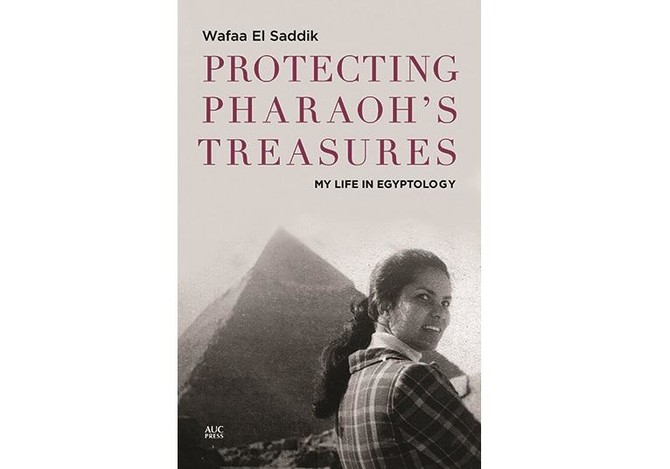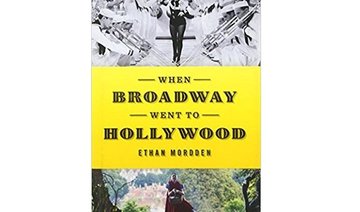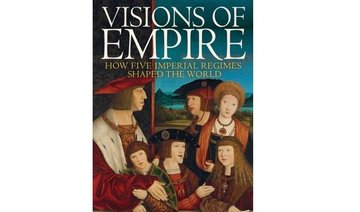Wafaa El-Saddik was the first female director of the Egyptian Museum in Cairo and held the post from 2004 until the end of 2010. During her final year at the museum, a popular uprising in Tunis caught the world by surprise, but El-Saddik had a premonition that similar events would also take place in Egypt. “We knew that the social gap could not continue to widen forever. It was only a question of time before something had to happen,” she writes in her book, “Protecting Pharaoh’s Treasures.”
In January of 2011, Egyptians from all walks of life expressed their long-oppressed feelings of anger. The first cracks in 30 years of dictatorship began to appear. It was a movement that prompted El-Saddik to write the book.
“The people who have worked toward a different Egypt for so long — decent, hardworking people of integrity — finally have to be given a chance. There have been, and still are, such people in Egypt, even among us Egyptologists in the antiquities service. They have distinct notions about a different Egypt. It was high time to open the drawer and lay on the table all the things that had had to wait too long.”
Her last meeting with former strongman Hosni Mubarak in October 2010 in Rome reveals what went on behind the scenes. Only five weeks before the Egyptian president’s state visit to Italy, El-Saddik was summoned to select ancient Egyptian artifacts for the exhibition in Rome. Deemed not spectacular enough, her selection was not approved. Zahi Hawass, who was chief of the antiquities office at the time, was now in charge of putting together a selection but he announced that a conflict of interest prevented him from attending the event. El-Saddik had to go to Rome after all and she was left to deal with a number of problems. The on-loan items were not insured, there was no exhibition catalogue and her co-workers had no visas. However, she remained positive, saying: “In my years as director of the Egyptian Museum I had learned one thing: If it has anything to do with the president, everything possible will be done, money is no object.”
After having worked “like dogs” to prepare the exhibition, El-Saddik was briefed that the visit should not take more than 15 minutes. Mubarak was tired and had problems standing up and Silvio Berlusconi was visibly not interested in the exhibition. When El-Saddik tried to draw their attention to the Egyptian Book of the Dead, she told both Berlusconi and Mubarak that “all those who have flouted the laws and offended those nearest to them are gobbled up by the devourer.” At that moment, she wrote, Mubarak smiled and photographs were taken. Who would have guessed then that by February, Mubarak would step down as president of Egypt?
The making of an archaeologist
When El-Saddik began university, she wanted to be a journalist. During a break, she went on an excursion to Luxor and Aswan organized by the faculty of archaeology. That trip changed her life as she decided to major in archaeology and was no longer interested in a journalistic career.
She quickly earned a reputation as somebody who stood up to figures of authority.
When President Anwar Sadat ordered that the upper part of the Khafre Pyramid be cleaned so it would become the same color as the pyramid’s lower part, she refused to follow the order. The chief inspector of the Giza precinct admonished her, saying: “Why haven’t you finished the job? How can you dare oppose a directive from the president?”
El-Saddik answered firmly: “How can you dare to order such nonsense?”
The inspector threatened to dismiss her so she filed a report explaining that the stones used for the construction of the lower and the upper part of the pyramid were from different quarries. The stones in the oldest part of the Khafre Pyramid came from the pyramid plateau, whereas the remaining stones were taken from the Tura limestone quarries. This clearly explains why the stones have different natural colors.
A few days later, the cleaning project was called off and this incident did not impact her career negatively. On the contrary, in 1976, El-Saddik became the first Egyptian woman to direct an excavation.
When El-Saddik was eventually appointed as the director of the Egyptian Museum in 2004, she wasted no time in doing an inventory of the objects piled up in the vast cellar of museum, which covers an area nearly the size of two football fields.
“The Egyptian Museum’s cellar is the stuff of legend…. For nearly 100 years it served as the central storeroom for all the artifacts awarded to Egypt in the division of finds,” she wrote.
To this day, Tutankhamen’s treasure remains Egypt’s most famous exhibition. After its worldwide tour between 1972 and 1982, a sculpture from the tomb’s treasure was damaged and the government issued a travel ban on the relics. That ban was lifted when Mubarak needed $500 million for his Grand Museum. El-Saddik curated the exhibition “Tutankhamen, the Golden Beyond” which toured the world and brought in around $100 million.
“Protecting Pharaoh’s Treasures” is a journey through El-Saddik’s life in Egyptology. As she looks back at the history of her country, we discover an amazing woman. She is truly in a league of her own.
Book Review: Dive into Egypt’s glorious past
Book Review: Dive into Egypt’s glorious past

What We Are Reading Today: ‘Crossing Thoughts’

Author: Sultan Ayaz
“Crossing Thoughts” is a fantasy novel in English by Saudi author Sultan Ayaz, published in 2017.
Ayaz’s novel is about humans defending their homeland against demon oppression. It is about the eternal fight between humanity and demons, and the person who stands between them.
The story begins with Drake, a child who lives a peaceful life with his family in a small town. However, a demonic attack destroys the village, but Drake somehow survives.
Three characters emerge: Aria, Ray and Amber, who study the nature of elements at the Grand College of Elements in the Kingdom of Iora, one of three kingdoms suffering demonic oppression. They learn to employ elemental magic as a weapon against their demonic opponents.
Aria (wind element user), Amber (fire element user) and Ray (thunder element user) end up fighting a sea demon and are discovered by a mysterious man called Soul, who admires their powers and helps them train to become “demon slayers,” to free humans from oppression.
There are many fight scenes in the storyline using magic and elements, and the book is full of drama, plot twists and terror.
What I liked about the narrative is how easy it is to read and follow, and the development of the world building —from the village to the Kingdom of Iora.
The female characters in the novel shine brighter and have distinct styles, making them more intriguing to read about, and each possesses a particular power.
It might be confusing for some readers that the story begins with Drake’s perspective and then cuts to the story of Aria, Amber and Ray. However, the more you read, the more intriguing the female storylines become.
The book has received four-plus star ratings on the Goodreads website and is simple enough to read in one sitting.
In 2020, Ayaz became one of the first Saudi novelists to have a fiction work in English published overseas when Olympia Publishers, a British publishing house, purchased the rights to “Crossing Thoughts.”
The novel is also set to be adapted into a Manga comic by Manga Arabia.
What We Are Reading Today: When the Bombs Stopped

Author: Erin Lin
Over the course of the Vietnam War, the United states dropped 500,000 tonnes of bombs over Cambodia—more than the combined weight of every man, woman, and child in the country.
Fifty years after the last sortie, residents of rural Cambodia are still coping with the unexploded ordnance that covers their land.
What We Are Reading Today: Father Time

Author: Sarah Blaffer Hrdy
It has long seemed self-evident that women care for babies and men do other things.
Puzzled and dazzled by the tender expertise of new fathers around the world— several in her own family—celebrated evolutionary anthropologist and primatologist Sarah Blaffer Hrdy set out to trace the deep history of male nurturing and explain a surprising departure from everything she had assumed to be “normal.”
What We Are Reading Today: ‘Breaking the Mold’

Authors: RAGHURAM G. RAJAN AND ROHIT LAMBA
India’s economy has overtaken the United Kingdom’s to become the fifth-largest in the world, but it is still only one-fifth the size of China’s, and India’s economic growth is too slow to provide jobs for millions of its ambitious youth.
In “Breaking the Mold,” Raghuram Rajan and Rohit Lamba show why and how India needs to blaze a new path if it’s to succeed.
What We Are Reading Today: ‘The Things You Can See Only When You Slow Down’

Author: Haemin Sunim
“The Things You Can See Only When You Slow Down: How to be Calm in a Busy World” offers advice on how to find inner peace in today’s busy world.
The 300-page book, published in 2017, was written by Haemin Sunim, a Korean Buddhist monk, and has sold more than 3 million copies.
The author underwent monastic training in South Korea before spending seven years teaching Asian religions at Hampshire College in the US. The book elaborates on the wisdom he gained from personal experiences as a Buddhist monk.
One of the book’s strengths is its simplicity. The author’s writing style is easy to understand as he presents his ideas in bite-sized chapters, each focusing on a different aspect of mindfulness.
Whether he is writing about the meaning of silence or of gratitude, Sunim’s words resonate with a quiet authority which prompts the reader to pause and reflect on their own lives.
In addition, the book is filled with amazing imagery that complements the stories. The beautiful drawings contribute to Sunim’s narrative and create a sense of serenity and peace.
The author emphasizes the concept of enjoying the little things in life to the fullest, such as drinking a cup of tea in the morning, taking a walk in nature, or having a thoughtful conversation with loved ones.
Slowing down allows people to notice the happiness hidden in even the simplest tasks and moments, he claims.
He also encourages readers to be kind to themselves and offers advice on how people can develop a deeper sense of self-acceptance and self-love, fostering emotional well-being and resilience.
Sunim’s wisdom and compassion are clear. His words remind readers that despite the noise and distractions of the modern world, true happiness can be found when they slow down.

















